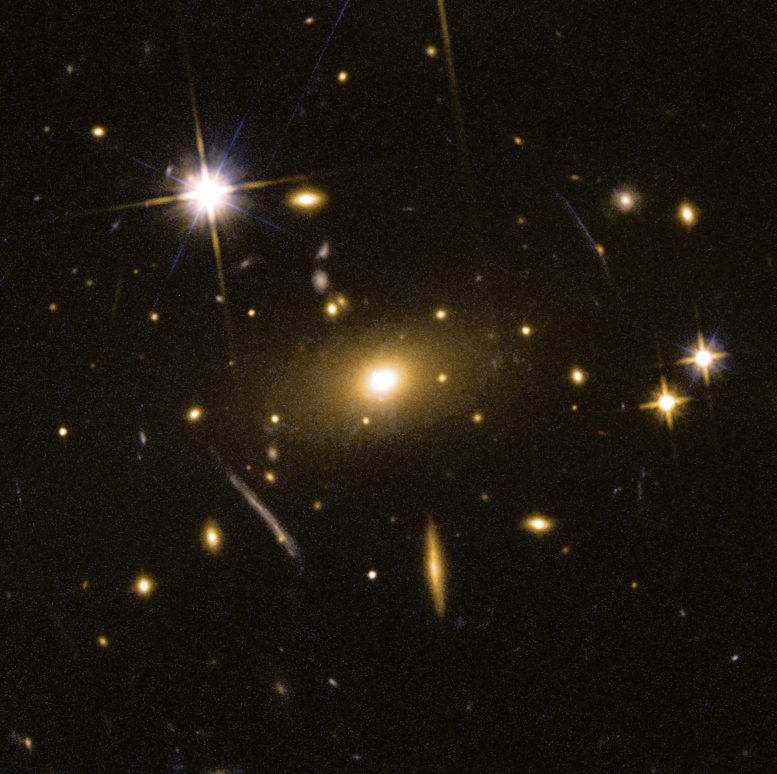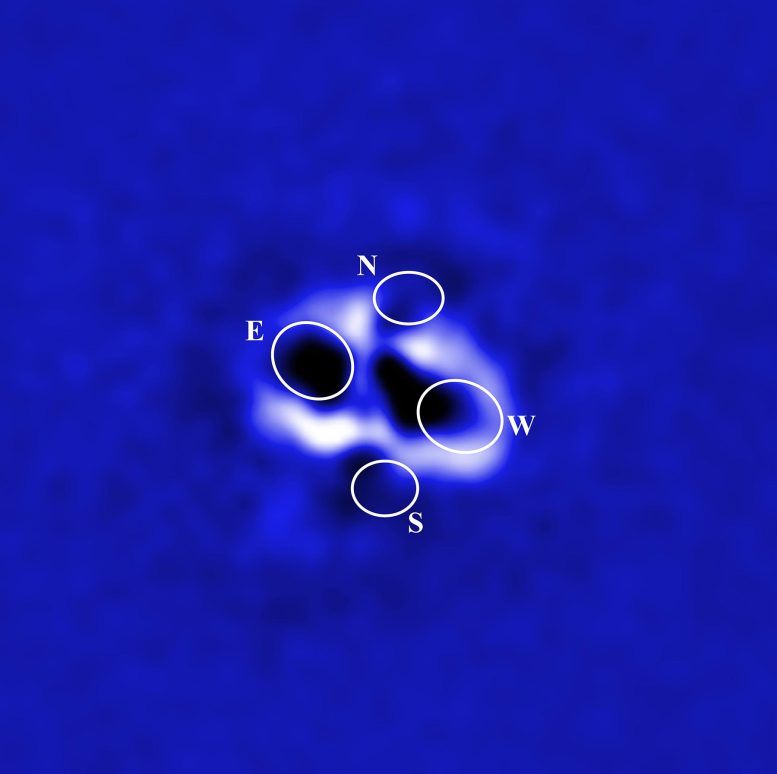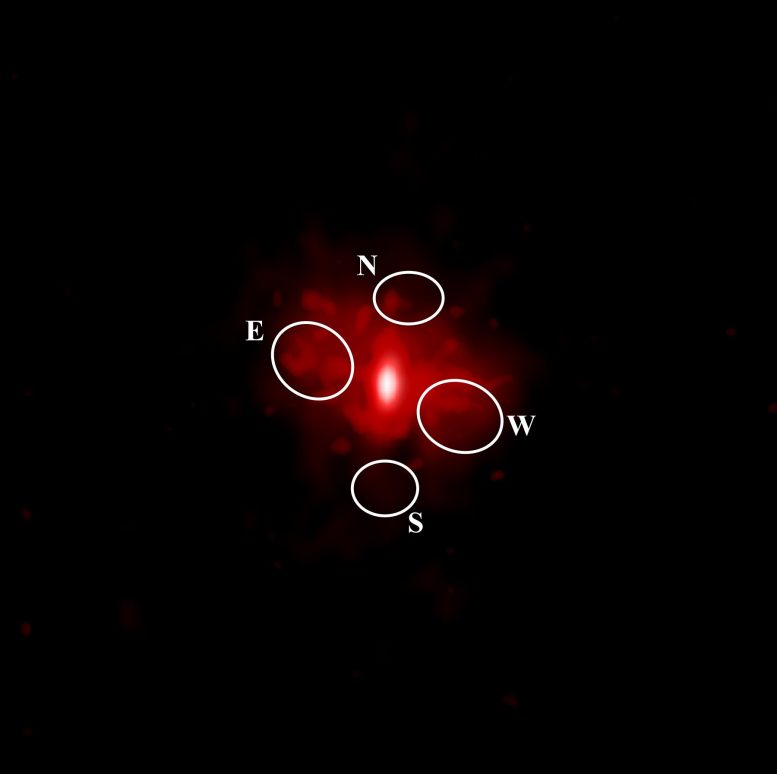
RBS 797 is a galaxy cluster located about 3.9 billion light-years from Earth. Four enormous cavities, or bubbles, have been found at the center of the RBS 797 galaxy cluster using Chandra. Hot gas that envelopes the individual galaxies is invisible in optical light, but it is detected in X-rays by Chandra. Scientists have seen many pairs of X-ray cavities before in other galaxy clusters, but four in the same cluster is very rare. The researchers think the quartet of cavities represents the essentially simultaneous explosive activity of a pair of supermassive black holes at the center of the galaxy cluster. Credit: NASA/STScl/M.Calzadilla
- Four cavities in the hot gas of a single galaxy cluster have been found.
- Astronomers found this quartet of X-ray cavities in the cluster located about 3.9 billion light-years from Earth using Chandra.
- This suggests there is a pair of supermassive black holes, both of which erupted and generated jets at about the same time.
- If confirmed, the two supermassive black holes would be among the closest pair ever discovered, with a separation of about 250 light-years.
Four enormous cavities, or bubbles, have been found at the center of a galaxy cluster using NASA’s Chandra X-ray Observatory. The left panel of this graphic shows an optical image of the galaxy cluster called RBS 797, from NASA’s Hubble Space Telescope. Hot gas that envelopes the individual galaxies is invisible in optical light, but it is detected in X-rays by Chandra (below). One pair of cavities can be seen towards the left and right of the center in the Chandra image as black oval-shaped regions. The other pair is less distinct, but can be found above and below the center of the image.

RBS 797 X-ray image. Credit: NASA/CXC/Univ. of Bologna/F. Ubertosi
Scientists have seen these X-ray cavities before in other galaxy clusters. A pair of cavities is thought to be a byproduct of eruptions from a giant black hole in a large galaxy at the center of a cluster. The eruptions power jets in opposite directions, which push gas away to create a pair of cavities. However, to produce four cavities each roughly pointing 90 degrees away from one another, a more complex phenomenon must be at play.

RBS 797 radio image. Credit: NSF/NRAO/ALMA
A team of astronomers studying RBS 797 think the most likely answer is that the galaxy cluster contains a pair of supermassive black holes, each of which has launched jets in perpendicular directions at almost the same time. Another possible explanation for the four cavities seen in RBS 797 is that there is only one supermassive black hole — with jets that somehow manage to flip around in direction quite quickly. Analysis of the Chandra data shows that the age difference for the east-west and north-south cavities is less than 10 million years.
Previously, astronomers observed the pair of cavities in the east-west direction in RBS 797, but the pair in the north-south direction was only detected in a new, much longer Chandra observation. The deeper image uses almost five days of Chandra observing time, compared to about 14 hours for the original observation. The NSF’s Karl G. Jansky Very Large Array had already observed evidence for two pairs of jets as radio emission, which line up with the cavities.
Reference: “The deepest Chandra view of RBS 797: evidence for two pairs of equidistant X-ray cavities” by Francesco Ubertosi, Myriam Gitti, Fabrizio Brighenti, Gianfranco Brunetti, Michael McDonald, Paul Nulsen, Brian McNamara, Scott Randall, William Forman, Megan Donahue, Alessandro Ignesti, Massimo Gaspari, Stefano Ettori, Luigina Feretti, Elizabeth L. Blanton, Christine Jones and Michael S. Calzadilla, 16 December 2021, The Astrophysical Journal Letters.
DOI: 10.3847/2041-8213/ac374c
arXiv: 2111.03679
A paper describing these results, led by Francesco Ubertosi (University of Bologna in Italy) appears in The Astrophysical Journal Letters. The other authors include Myriam Gitti (Univ. of Bologna), Fabrizio Brighenti (Univ. of Bologna), Gianfranco Brunetti (INAF), Michael McDonald (Massachusetts Insitute of Technology), Paul Nulsen (Center for Astrophysics | Harvard & Smithsonian), Brian McNamara (Perimeter Institute), Scott Randall (CfA), William Forman (CfA), Megan Donahue (Michigan State University), Alessandro Ignesti (INAF), Massimo Gaspari (INAF), Steffano Ettori (INAF), Luigina Feretti (INAF), Elizabeth L. Blanton (Boston University), Christine Jones (CfA), and Michael S. Calzadilla (MIT).
NASA’s Marshall Space Flight Center manages the Chandra program. The Smithsonian Astrophysical Observatory’s Chandra X-ray Center controls science from Cambridge Massachusetts and flight operations from Burlington, Massachusetts.









billions and billions of a billion billions of light years away 🤣
Who’s the scientist Dr. evil? 🤣🤣
GTFOH.
Well what is going on here i thought it’s here or is it 100 light years from earth is it really
3.9 billion light years from earth or not more they say it’s light years from earth more unnacceptable it get’s sheesh.
jean is obviously an idiot, probably a yec moron with a reading comprehension problem who should go back to school. so is the one who really needs to GTFOH
tag can’t even write in english.
both prime examples of people too stupid to comprehend anything, so they attack knowledge they don’t understand in order make themselves feel less like the ignorant buffoons they are , rather than try to actually learn something.
The centers of the jets are off-set and the axes are at different angles. Which means intermittent feeding orbiting black holes with different axes, or a less probable very wildly wobbling black hole with an inexplicable precession.